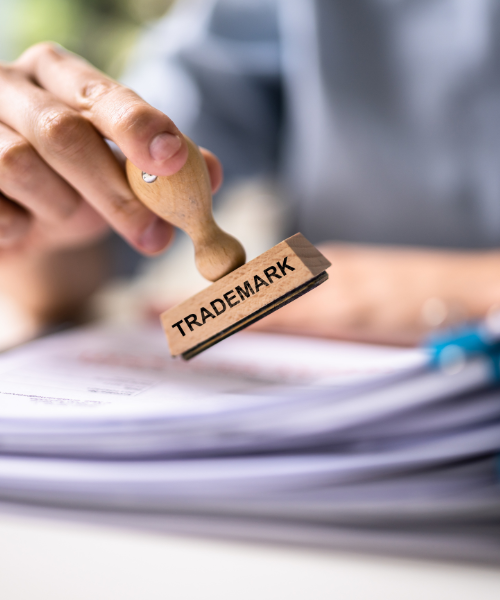
Trademark Registration
- Trademark Registration
- Trade mark search and application filing under one
- Subsidized
Documents Required
- Incorporation Certificate
- Partnership Deed
- PAN Card
Get In Touch
1. Trademark Registration
- Trademark Registration
- Trade mark search and application filing under one
- Subsidized
- Trade mark Filing including Government fee for individuals and
- Full Price
- Trade mark Filing including Government fee for entities NOT having MSME
· Documents Required
- Incorporation Certificate Partnership Deed
- PAN Card
- Trademark Registration
- Building a brand takes a lot of time, effort and capital. As a result, it’s necessary to make sure that you possess the rights to use your brand’s logo, tagline, product shape and packaging, sound, fragrance, color combinations, and anything else that gives it a distinct identity. Trademark is a type of intellectual property which differentiates your product or services from other competitors in the market.
- In India, the Trademark Act,1999 permits you to register a It allows for exclusive ownership rights and prohibits others from using the mark, favoring the registered mark’s owner.
- Once a trademark is registered, the “TM” symbol can be used with the applicant and the To protect the brand name, trademark registration in India is essential. It is typically best to seek trademark registration under the supervision of a professional, as the process entails several steps and needs constant government follow-up.
- Eligibility for Trademark Registration
- Trademark registrations are prevalently used to protect unique brands, slogans, or invented terms. Individuals, corporations, and non-profit organization can all file for trademark registration in India. However, each class of person or entity has its own set of requirements when it comes to filing a trademark In India, the following are eligible for trademark registration.
- An individual (Person)
- An individual who is not doing any business can also obtain a trademark application and obtain trademark registration for a symbol or word that is proposed to be used by the applicant in the future.
- Joint Owners
- The Joint owners of a company together can file for a trademark and both their names must be mentioned in the application.
- Proprietorship Firm
- A proprietorship firm may file a trademark application under its proprietor’s name but not under the business and proprietorship If you include a proprietorship name and a business name in your application, those details will be considered separately.
- Partnership Firm
- A partnership company must include all the names of the partners in the application while registering for a trademark, with a maximum of ten If a minor partner is present, the name of the minor’s guardian representing him must be mentioned.
- Limited Liability Partnership LLP
- In the case of the Limited Liability Partnership, the application should be in the name of the It is an incorporated body where the partners have their own identity. The partners cannot be the applicant as the trademark belongs to the LLP.
- Indian Company
- Any Indian company, regardless of weather a private limited, limited, or anyother form, must file a trademark application in the company’s It should be noted that any incorporated entity has its own identity, so a company’s director cannot be a trademark applicant.
- Foreign Company
- If a foreign incorporated entity applies for a trademark in India, the application must be made in the corporate name as it is registered in the foreign The nature of the registration, the country, and the law should all be mentioned here.
- Trustor Society
- If a trademark application is filed on behalf of a trust or society, the managing trustee, chairman, or secretary who is representing the trust or society must be named.
2. Trademark Objection
Trademark Objection
Drafting and filing of reply for objection raised by Trademark Examiner.
Documents Required
Advertisement Copy Product Images Sales Invoice
Trademark Objection
An application for registration of a trademark can be objected by the Trademark Office for a number of reasons. In this article, we look at the top reason for trademark objection.
Trademark Objection
Once a trademark application is filed, a Trademark Examiner examines the the application and makes a search of earlier trademarks – which are identical or similar to the mark being examined. The findings of the Trademark Examiner are compiled as the trademark examination report.
Use of Incorrect Trademark Form
In case the trademark application is not made on the proper form, an objection as following is raised by the Trademark Examiner.
“The application is made on form TM-1, for certification mark in respect of goods or services falling in a class, the form of the application should be corrected as TM-4 by filing a request on form TM-16.”
Corrective Action: The applicant can overcome this objection by requesting to correct trademark application by filing a request on form TM -16.
Incorrect Trademark Applicant Name
The trademark applicant name must be entered properly in an application, as suggested in this article. In case of incorrect trademark applicant name, the Trademark Examiner would raise an objection as follows:
“The application appears to have been filed in the name of a partnership firm, names of all Partners of the firm should be brought on record by filing a request form TM-16”
Corrective Action: The applicant can overcome an objection for incorrect trademark applicant name by requesting to correct trademark application by filing a request on form TM -16.
3. Trademark Opposition
Drafting and filing of opposition notice. Exclusive pricing for trademark applications filed by Apnataxwala CA.
· Documents Required
Signed Evidence Sales Invoice Advertisement Copies
Trademark Opposition
Trademark opposition in India comes at a stage after the registrar has approved the trademark application on the grounds of distinctiveness and published the third-party opposition’s trademark in the journal.
Eligibility
According to Section 21 of the Trademark Act, ‘any person’ can oppose a trademark, irrespective of their commercial or personal interest in the matter. A trademark can be countered by filed by a customer, member of the public or competitor, or any other person. Also, the person filing the trademark opposition needs to be a prior registered trademark owner.
After a trademark opposition is filed, both parties need to conclude whether the trademark should be abandoned or registered
Anyone who believes that the published mark might create confusion among the public can file for the opposition while defending the trademark lies in the trademark registrant’s hands.
4. Trademark Renewal
Drafting and filing of trademark renewal application. For individuals, proprietorship's, registered SMEs and registered Startups.
· Documents Required
Form-48
Trademark Renewal
A trademark is used by a business to distinguish its goods or services from other similar goods or services from a different business. The trademark symbols, logos, labels, names are represented with an “R” at the end. A trademark can be registered under the Trade Marks Act, 1999. The trademark cannot be registered if it is found offensive, non-distinct and contains government emblems.
The validity period of trademark in India is for a period of 10 years as per section 25 in the Trade Marks Act, 1999. On 6th March 2017, Government of India (GOI) notified new Trade Mark Rules, 2017, to streamline the application process, create benchmarks for filing trademark applications, promote e-filing and simplify the registration process.
Renewal of a Trademark Duration to renew a Trademark
- The renewal can be filed within one year prior to the date of expiry as per rules 57 and 58 in Trade Mark rules 2017.
- There new al can be filed within six months prior to the date of expiry as per rules 63 and 64 in Trade Mark rules 2002.
- The renewal can also be filed within six months after the date of expiry. Negligence to renew a mark within six months after the date of expiry will lead to the removal of the mark from the Register of Trademarks.
5. Copyright Registration
Copyright registration for logos, books, periodicals and magazines.
· Documents Required
PAN Card
Aadhar Card Incorporation Certificate
Copyright Registration
Copyright refers to the ownership rights to literature, theatre, music, artwork, sound recordings, and other works. Copyright registration grants a set of rights to the work, including reproduction, public communication, adaptation, and translation. Copyright registration ensures that the writers’ rights to ownership and enjoyment of their works are protected and rewarded, which protects and rewards creativity.
Copyright registration is required since it allows you to communicate with the public, reproduce the rights, adapt, and translate the works.
As understanding of intellectual property rules has grown, there has been a significant increase in the amount of intellectual property being registered in India. One of the most important types of intellectual property protection is copyright registration.
The Copyright Act of 1957 governs the process of copyright registration. The author’s creative work cannot be replicated since no one is permitted to use it without the author’s or creator’s consent. The author has the right to charge for the use or modification of their work. The copyright is usually protected for 60 years.
Benefits of acquiring Copyright Registration Provides Legal Protection
The creators enjoy legal protection when their work is reproduced without authorization. Registering a Copyright makes it much easier to protect the original work against infringement.
Market Presence
Copyright registration creates a public record of the work, and proof of ownership is established for the creative work.
Rights Of The Owner
The owner of registered copyright gets the rights to reproduce, disseminate and adapt and translate the work.
6. Design Registration
Design registration for one article, wherein the applicant is a proprietor or individual.
Design Registration
Design registration is a type of intellectual property protection under which a newly created design applied to an article created under an industrial process can be protected from counterfeiting. This registration provides authority to the owner to use the Design for ten years, and the time can be further extended for the next five years. The present article briefs the Design Registration procedure in India.
Definition of a Design
A design is defined under Section 2(d) of the Designs Act 2001, as only the features of a shape, pattern, configuration, composition, or ornament of lines or colors that are applied to any article that is two dimensional, three dimensional, or both by an industrial process or any means whether mechanical, manual or chemical, separated or combined, which in the finished article are judged solely by the eye; but is not taken into account upon the principle of construction or anything which is in substance a merely mechanical device.
Advantages of Design Registration in India
Following are some advantages that an owner can avail after getting registration of a design in India:
- Exclusive rights over the new and original design
- An asset of the proprietor/owner
- Can initiate a legal proceeding in case of infringement by a third-party
- Serve as a prima facie evidence in an infringement suit
- Right to sell, transfer and license the design with ease
7. Provisional Patent
Complete specifications registration of device patents (non- provisional) with the Indian Patent Office. Complete drawings/ illustrations, abstract and claims to the provided by the client which will be vetted by India Filings expert.
Patent Registration
Patent registration can be obtained in India for an invention. A patent is a right granted to an individual or enterprise by the government that disallows others from making, using, selling, or importing the patented product or process without the patent holder’s approval or consent.
The primary step an inventor takes to safeguard their innovation from being exploited is to file a patent. Patent application in India is a time-consuming procedure, but you can have your registration completed your registration in a hassle-free way.
Types of Patent Application in India
Provisional Application – A provisional application, also known as a temporary application, is filed when an invention is still in the works and has not yet been finished. Any other relevant inventions will not be recognized as prior art to the inventor’s application if a patent is filed early. When an invention requires more time to develop, this form of patent application is filed.
Ordinary or Non-Provisional Application – An ordinary or non-provisional application application does not have any priority to claim or if the application is not filed in pursuance of any preceding convention application. A complete specification can be submitted via:
Direct Filing – Wherein complete specification is initially filed with the Indian Patent Office without filing any corresponding provisional specification.
Subsequent Filing – Wherein complete specification is filed after the filing of the corresponding provisional specification and claiming priority from the filed provisional specification.
Convention Application – The convention application is filed for claiming a priority date based on the same or similar application filed in any of the convention countries.
To avail a status of the convention, an applicant must apply to the Indian Patent Office within a year from the date of the initial filing of a similar application in the convention country.
To re iterate in simpler terms, a convention application entitles the applicant to claim priority in all the convention countries.
PCT International Application – PCT international application does not result in an international patent grant, it open the way for a shortened patent application process in multiple nations at once.
It is governed by the Patent Corporation Treaty, which can be validated in up to 142 nations. By filing this application, an innovation will be protected from being copied in these nations.
PCT National Application – If the applicant discovers an innovation, or a modest modification of an invention, that has already been applied for or patented by the applicant, he must file this application. If the invention does not need a significant inventive step, a PCT National application can be filed.
Divisional Application – If an application claims more than one invention, the applicant may choose to partition it and submit two or more applications. These applications have a priority date that is comparable to the parent application.
8. Patent Registration
Complete specifications registration of device patents (non- provisional) with the Indian Patent Office. Complete drawings/ illustrations, abstract and claims to the provided by the client which will be vetted by India Filings expert.
Patent Registration
Patent registration can be obtained in India for an invention. A patent is a right granted to an individual or enterprise by the government that disallows others from making, using, selling, or importing the patented product or process without the patent holder’s approval or consent.
The primary step an inventor takes to safeguard their innovation from being exploited is to file a patent. Patent application in India is a time-consuming procedure, but you can have your registration completed your registration in a hassle-free way.
Types of Patent Application in India
Provisional Application – A provisional application, also known as a temporary application, is filed when an invention is still in the works and has not yet been finished. Any other relevant inventions will not be recognized as prior art to the inventor’s application if a patent is filed early. When an invention requires more time to develop, this form of patent application is filed.
Ordinary or Non-Provisional Application – An ordinary or non provisional application application does not have any priority to claim or if the application is not filed in pursuance of any preceding convention application. A complete specification can be submitted via:
Direct Filing – Wherein complete specification is initially filed with the Indian Patent Office without filing any corresponding provisional specification.
Subsequent Filing – Wherein complete specification is filed after the filing of the corresponding provisional specification and claiming priority from the filed provisional specification.
Convention Application – The convention application is filed for claiming a priority date based on the same or similar application filed in any of the convention countries.
To avail a status of the convention, an applicant must apply to the Indian Patent Office within a year from the date of the initial filing of a similar application in the convention country.
To re iterate in simpler terms, a convention application entitles the applicant to claim priority in all the convention countries.
PCT International Application – PCT international application does not result in an international patent grant, it open the way for a shortened patent application process in multiple nations at once.
It is governed by the Patent Corporation Treaty, which can be validated in up to 142 nations. By filing this application, an innovation will be protected from being copied in these nations.
PCT National Application – If the applicant discovers an innovation, or a modest modification of an invention, that has already been applied for or patented by the applicant, he must file this application. If the invention does not need a significant inventive step, a PCT National application can be filed.
Divisional Application – If an application claims more than one invention, the applicant may choose to partition it and submit two or more applications. These applications have a priority date that is comparable to the parent application.
Apna Tax Wala © 2025 All Rights Reserved.

